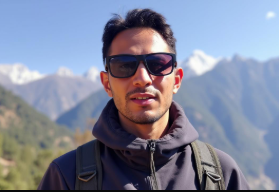10 Days Annapurna Circuit Trek
Trip Type
Trekking In Nepal
Accomodation
Tea House
Destination
Nepal
Start Point
Kathmandu
Region
Annapurna Region
Duration
10 Days
10 Days Annapurna Circuit trek is a short and famous trek in Annapurna region. This trek is ideal for those who have a limited amount of time for outdoor activities. This short Annapurna Circuit trek 10 days itinerary offers a harmonious blend of breathtaking mountain vistas, rich cultural encounters, and diverse landscapes, all within a manageable timeframe. Along the way, you'll experience the warm hospitality of local communities, including Gurungs, Thakalis, and Manangis, making your journey even more special.
Whether you want to challenge yourself with the Everest Base Camp Trek, explore the pristine beauty of the Manaslu Circuit Trek, or enjoy a shorter trek like the Ghorepani Poon Hill Trek, there's something for everyone.
Our Annapurna Circuit Trek package is designed to offer the best value at an affordable price, ensuring you get a once-in-a-lifetime experience without stretching your budget.
Best Time for Annapurna Circuit Trek
Understanding the seasonal variations is crucial for a rewarding trek:
- Spring (March-May): Experience moderate temperatures, clear skies, and vibrant rhododendron blooms, enhancing the trail's beauty.
- Autumn (September-November): Enjoy stable weather and excellent visibility, making it the most popular season for trekking.
- Winter (December-February): Expect colder temperatures, especially at higher altitudes, with potential snowfall making certain sections, like Thorong La Pass, more challenging.
- Monsoon (June-August): Trails can be slippery due to rainfall, but the lush greenery offers a unique perspective. The Upper Mustang side trek is a viable alternative during this season.
Why Choose Nepal Outdoor Expeditions for Your Annapurna Circuit Trek?
At Nepal Outdoor Expeditions, we pride ourselves on delivering exceptional trekking experiences. Our seasoned guides, deep local insights, and commitment to safety ensure that your Annapurna Circuit trek 10 days journey is both memorable and secure. We tailor our services to meet your preferences, providing a personalized adventure that stands apart.
Comparing Annapurna Circuit with Other Circuit Treks
The Annapurna Circuit Trek is one of Nepal’s most iconic trekking routes, offering a mix of diverse landscapes, cultural richness, and moderate adventure. Compared to the Everest Three Passes Trek, which is more challenging with extreme altitudes, Annapurna provides a more gradual ascent, making it accessible to more trekkers.
For those looking for a remote and rugged experience, the Manaslu Circuit Trek is a great alternative, featuring untouched trails and fewer crowds. Meanwhile, the Langtang Circuit Trek is shorter and closer to Kathmandu but lacks the high-altitude diversity of Annapurna.
If you seek a drier, Tibetan-influenced terrain, the Upper Mustang Circuit Trek offers a unique Himalayan desert experience. On the other hand, the Kanchenjunga Circuit Trek is a demanding journey for seasoned trekkers, covering vast wilderness and fewer teahouse facilities.
How much does 10 Days Annapurna Circuit Trek cost?
At Nepal Outdoor, the 10 Days Annapurna Circuit Trek costs $1175 per person. This price includes everything you need for a comfortable and memorable trek. You can check the breakdown of what’s covered in this package page.
Preparation and Essentials
To ensure a successful trek:
Physical Fitness: While suitable for beginners, the trek involves numerous ascents and descents. Regular cardiovascular exercises and strength training are recommended to prepare for long walking hours.
Packing List
- Clothing: Layered attire including thermals, fleece jackets, and waterproof shells.
- Footwear: Sturdy, waterproof trekking boots with good ankle support.
- Gear: Trekking poles, headlamp, daypack, and a quality sleeping bag.
- Accessories: Sunscreen, sunglasses, water purification tablets, and personal first-aid kit.
- Permits: Obtain the TIMS card and Annapurna Conservation Area Permit (ACAP) prior to commencing the trek.
- Altitude Acclimatization: Stay hydrated, ascend gradually, and be aware of altitude sickness symptoms. Carrying medication like Diamox can be beneficial.
Highlights of the 10 Days Annapurna Circuit Trek
- Cross the iconic Thorong La Pass (5,416m) with panoramic Himalayan views.
- Experience the transition from lush valleys to high-altitude deserts.
- Witness the grandeur of the Kali Gandaki Gorge, the world's deepest.
- Optional visit to Tilicho Lake, a stunning high-altitude glacial lake.
- Explore culturally rich villages and sacred sites, including Muktinath Temple.
- Savor the renowned apples and apple products of Jomsom and Marpha.
- Enjoy breathtaking views of peaks like Annapurna I-IV, Dhaulagiri, and Tilicho Peak.
- Relax in the natural hot springs at Tatopani, soothing your muscles after the trek.
Short Itinerary ( 10 days )
You’ll travel in a jeep to Chame and witness the beautiful scenery along the way. Chame is the entry point of Annapurna Circuit. Distance:150 km, altitude gain: 1400m
You’ll start your trek and pass through pine forest and george. You can witness the views of Manaslu and Annapurna II. Pisang offers the traditional Tibetan culture and stunning views. Distance: 10km, walking hours: 5-6, altitude gain: 630 m
You’ll continue trekking to Manang which is a village with stunning mountain views and when you reach Manang it will be the acclimatization day for you to prevent from altitude sickness. You can explore monasteries in the village. Distance: 14km, walking hours: 5-6, altitude gain: 240 m
You can rest for the day or you can hike to Tilicho Lake. You can explore the Manang valley. Distance: 10-12 km, walking hours: 4-5 hrs, altitude gain: 500 m.
It is an acclimatization day so you’ll have a short hike to Yak Kharka. You can enjoy the views of Annapurna II and Gangapurna mountains. Stay overnight at a tea house. Distance: 10km, walking hours: 4-5, altitude gain: 490 m
A short trek to Thorong Phedi which is the last stop before crossing Thorong La Pass. Distance: 6km, walking hours: 3-4, altitude gain: 420m
You’ll cross the Thorong La Pass. After that you’ll trek to Muktinath all the way down. Stay overnight at a tea house in the Muktinath area. Distance: 18km, walking hours: 8-10, altitude loss: 1706 m(from Thorong La Pass)
A short trek to Jomsom and enjoy the apple pies, cider as it is the capital of apples. Distance:12 km, walking hours: 3-4, altitude loss: 1000m
You’ll drive to Pokhara from Jomsom and explore the city or rest for the day. Stay overnight at a hotel in Pokhara.
You’ll fly back to Kathmandu or go by road to Kathmandu. After you reach Kathmandu you’ll be transfer to the International Airport for your departure.
Cost Includes
-
Cost of permits and paperwork
-
Transportation cost
-
Accommodation
-
Meals and Drinks
-
Cost of trekking staff
-
Miscellaneous cost like government tax and service
Cost Excludes
-
Personal expenses
-
Trekking gear and equipment
-
Insurance and emergency cost
-
Tips for guide or porter
Trip FAQS
More Trip Informations
Cultural and Natural Highlights
Traverse through diverse ecosystems, from tropical forests to alpine terrains, and immerse yourself in the rich tapestry of local cultures. The trek encompasses sacred sites like the Muktinath Temple, revered by both Hindus and Buddhists, and passes through traditional villages such as Manang and Pisang, where you can experience authentic Gurung and Magar hospitality.
Marvel at natural wonders including the world's deepest Kali Gandaki Gorge and, if desired, take a detour to the mesmerizing Tilicho Lake, one of the highest glacial lakes globally.
Sustainable Trekking Practices
As stewards of this pristine environment, we encourage:
- Waste Management: Carry reusable water bottles and avoid single-use plastics. Dispose of waste responsibly.
- Local Engagement: Support the local economy by purchasing local products and choosing accommodations that implement sustainable practices.
- Environmental Respect: Refrain from picking plants or disturbing wildlife, and always stick to designated trails to minimize ecological impact.


.png)

